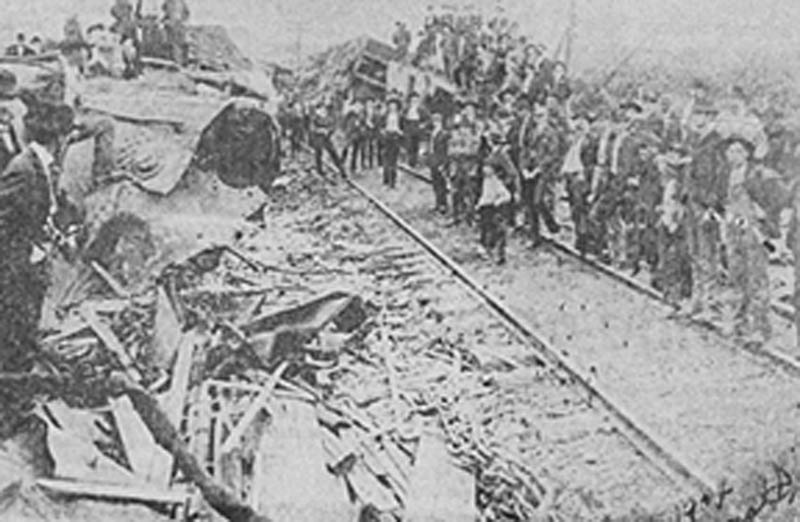1904 train catastrophe (conclusion)

Unfortunately Train 15 was supposed to stop on a side track at Hodge’s Switch to allow the larger Carolina Special to safely pass. It didn’t stop. It was Sept. 24, 1904.
The two trains sped toward each other and time was running out. The communications options that are in use today weren’t available in that era. A calamity awaited them just ahead. Train 15 “was barrelling down the steep grades” to what was known in railroad parlance as a “dip.” A blind curve was ahead.
Both engineers caught sight of each other’s train at Whitaker’s Farm and the emergency brakes were immediately applied. It was too late. Both were traveling at far too great a speed to stop or to slow down but very little. They slammed together head-on, on New Market Hill, at 10:18 a.m.
The locomotive and coal tender of Train 15 were thrust into the air by the collision. The coal tender was turned upside down as it catapulted over the engine, tender and baggage cars of the Carolina Special. Train 15 landed atop the wooden passenger cars, resulting in them being reduced to massive piles of splinters under the crushing weight. Death came quickly to many of the victims, decapitated or horribly mangled, with screaming continuing from the injured surviving passengers even after the smoke, steam, dirt and grime had settled. Those aboard the lighter Train 15 were more fortunate, as it landed on its side and began sliding for a considerable distance.
Both G.M. “Dick” Parrott and William Kane, engineers of the two trains, were laid side by side on the ground, not far from the point of collision. They had been found beneath a mass of iron, steel and wood mixed with human bodies.
“When I heard the rumble of the two trains coming, I looked up and was able to see the terrible happening,” said Joseph J. Whitaker, an eyewitness who was gathering corn with a mule team and wagon. “I tied the mules to the wagon as quickly as I could because I knew they would be frantic over the noise of the crash.
“The trains were approaching each other at a fast speed. I knew they were on a single track. Both trains were belching black smoke from both engines as they came closer and closer. I knew they couldn’t stop in time and would crash. I couldn’t take my eyes away.
“It was almost destroyed beyond description. The steam engines rolling at a frightful speed and ripped into each other, filling the air with splinters of wood and mangled metal. It actually caused the ground to tremble. The impact was so great the boilers of both engines exploded and reared high into the air. They fell back to Earth in a grotesque heap near where I was working.”
It was reported that shortly after noon, a hundred or more workmen were sorting through debris, removing bodies and caring for the injured. A rescue train left Chattanooga within an hour with a track right-of-way above all others. A claims official from the Southern Railway Company arrived in mid-afternoon with $30,000 in cash and began settling claims on the spot.
A relief train from Knoxville also arrived, bringing doctors and medical supplies to the crash scene as well as photographers and enterprising reporters who snuck aboard and then exited a little before the train arrived to keep from being detected.
The injured were taken to the Knoxville General Hospital. Many passengers had been impaled by timbers when the wooden railway cars were splintered. Others were decapitated. Thousands of Knoxville area residents arrived trying to find out about family members. Large numbers of curiosity seekers also arrived.
When the hospital overflowed, others were taken to private homes. All doctors in the area, approximately 40, were called into service. There were near riots when bodies began arriving and loved ones couldn’t find funeral homes. City police guarded the entrances and allowed only small numbers in at a time.
So it was in the era of the train catastrophe near New Market, Tennessee, when the railroad system was still in its infancy. Our ancestors loved the trains, ascinated as they brought them much closer to the outside world and the outside world to them. Oh, there were ghastly accidents like the one reported herein, but they continued using the Iron Horse. It brought improved transportation and services, while allowing the means to get our natural resources to the outside world. America was growing.
(C) 2022, Jadon Gibson
Jadon Gibson is a freelance writer from Harrogate. His writings are both historic and nostalgic in nature. Thanks to Lincoln Memorial University, Alice Lloyd College and the Museum of Appalachia for their assistance.


